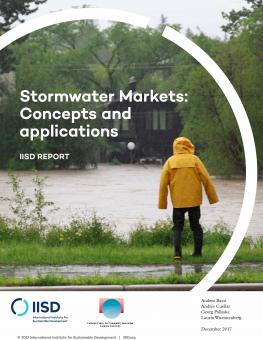
Stormwater Markets: Concepts and applications
This paper provides an overview of the technology and financing options available to address the stormwater problem in urban areas. The analysis focuses on policy instruments for incentivising private investments into green infrastructure, specifically through the creation of stormwater markets.
This paper provides an overview of the technology and financing options available to address the problem and better plan for stormwater market management. Specifically, the analysis focuses on the creation of stormwater markets.
Finding solutions to the stormwater problem is critical. Urban areas are rapidly expanding, climate variability is increasing, and social and environmental impacts are becoming more difficult to anticipate and more expensive to fix. In addition, funds are simply not available from the public sector to meet the increasing needs for capital and operation and maintenance costs of water management infrastructure.
Instead of targeting the management of stormwater runoff by centralized, end-of-pipe and capital-intensive gray infrastructure, green infrastructure aims to increase surface infiltration and lower the amount of stormwater at the source. Green infrastructure requires interventions by land and property owners, representing a decentralized approach to stormwater management. While investments would take place primarily on private property, the benefits of such interventions would be felt by many. As a result, the economics of the investment have not made these interventions very popular in the past. Policy support is needed to stimulate private investments.
The vast majority of empirical cases are examples of policy implementation (either individual policies or a portfolio of options), but the implementation of stormwater markets is also on the rise. These represent a quantity-based approach, with a set number of allowances, normally declining over time. Available options include credit trading and the creation of a mitigation bank. Various additional mechanisms can be used to create incentives for investments in stormwater management. Examples include in-lieu fees, permittee-responsible mitigation (offsets) and a combination of policy instruments.
The opportunities emerging from the establishment of stormwater markets are considerable, especially when considering the potential social, economic and environmental impacts. To obtain such benefits, and in light of the design and implementation challenges identified, a customized approach is required. This would ensure that the market is designed to create synergies with existing legal frameworks and generate enough buy-in to work effectively for a variety of economic actors, a key requirement to reach scale.
Participating experts
You might also be interested in
The Role of Multilateral Development Banks for Low-Carbon Procurement in the Infrastructure Sector
This report examines the critical role of multilateral development banks (MDBs) in advancing low-carbon procurement within the infrastructure sector.
Sustainable Asset Valuation (SAVi) of a Small-Scale Tree Planting Initiative in Côte d'Ivoire
This report analyzes the social, economic, and environmental outcomes of a small-scale tree planting initiative at schools in Côte d'Ivoire.
Green Public Procurement in India
This report analyzes the status of green public procurement (GPP) in India and suggests key strategies for advancing sustainable procurement practices.
Sustainable Asset Valuation of the Nutrition Sensitive Agriculture Capacity Strengthening Project in Ethiopia
This report analyzes the social, economic, and environmental outcomes of implementing agroforestry and climate-smart agriculture in Ethiopia.